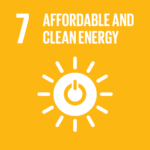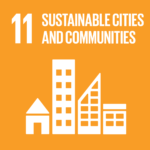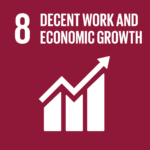We are continually looking at ways to expand our innovative resource recovery and recycling, which reduces our greenhouse gas emissions by diverting waste from landfill and reduces demand for primary raw materials.
We are continually looking at ways to expand our innovative resource recovery and recycling, which reduces our greenhouse gas emissions by diverting waste from landfill and reduces demand for primary raw materials.
Cleanaway has released its FY21 Sustainability Report, expanding on the material topics and global standards for sustainability that the company is working towards, including the United Nations Sustainable Development Goals (SDGs).
The company continued to take action in FY21 to achieve the seven United Nations SDGs it has prioritised:

SDG 7: Affordable and clean energy
At present, resource recovery is not an option for all waste streams. Greenhouse gas emissions are a natural consequence of waste ending up in landfill. Energy from waste represents an important alternative to engineered landfill for managing waste that cannot be sustainably recovered. In addition to the safe management of residual waste, it also enables the generation of low carbon energy.
Energy from waste
A large proportion of waste continues to go to landfill either because it is too contaminated to be recovered for recycling or there is no current option for resource recovery. Landfills produce methane, a greenhouse gas that is 28 times more potent than carbon dioxide, as waste decomposes.
Cleanaway is investing in world-leading technology to recover energy from waste (EfW) while transitioning to a lower carbon economy. In FY21, we captured about 108 million cubic metres of landfill gas and used some of it to generate about 130 gigawatts of renewable energy, which is enough to power about 27,000 homes.
Solar energy
We are investing in solar energy systems across Australia to reduce our demand from the electricity grid and to reduce our annual power bill, with photovoltaic panels being installed at 24 sites in a program to be completed this calendar year.
![]()
SDG 9: Industry innovation and infrastructure
Our network of prized assets provides critical infrastructure to support a circular economy and contribute to making a sustainable future possible, with the capacity to service the needs of the community. They include our resource recovery and recycling facilities, transfer stations, engineered landfills, liquid treatment plants and refineries.
Resource recovery investment
We continuously explore leading technology and processes to enable the circular economy and deliver innovative customer solutions, such as a packaged food waste recycling service introduced through our partnership with Coles supermarkets, which reduces food waste sent to landfill.
We are the upgrading our Victoria Commingled Resource Recovery (VCRR) network, including the Laverton North material recovery facility and plastic recovery facility in Melbourne.
We have spent more than $15 million upgrading resource recovery sites in Queensland, South Australia and Victoria, and acquired the Grasshopper Environmental construction and demolition (C&D) collections business in NSW.

SDG 15: Life on land
We adhere to all environmental legislation and licensing requirements to minimise adverse effects on the environments in which we operate. We conduct our activities with the intention of preventing contaminants escaping and causing harm to the environment.
Environmental risks
In FY21, we made significant progress in simplifying and standardising management of environmental risks at our sites. An important milestone was the launch of the four Environment Absolutes alongside our revised Lifesaving Rules, which elevates environment protection and compliance to the importance of safety.
To complement the launch, Cleanaway undertook tailored environmental awareness training. We have also introduced a series of critical risk work programs that will ensure embedded management of our most material environmental risks.
Perth MRF infrastructure improvements
The Perth Material Recovery Facility, which was destroyed by fire in November 2019, was rebuilt and reopened in May 2021.
We worked with government bodies and an externally appointed independent fire engineer to ensure the redevelopment met the highest standards for safety, sustainability and fire and operations management and incorporated a range of fire safety enhancements.

SDG 12: Responsible production and consumption
Cleanaway has a critical role to play in the sustainable management and use of natural resources, the responsible management of chemicals and waste, and supporting reduction in waste generation. We believe that waste is a resource, and we focus on extracting the maximum potential from every tonne.
We are continually looking at ways to expand our innovative resource recovery and recycling, which reduces our greenhouse gas emissions by diverting waste from landfill and reduces demand for primary raw materials. In FY21 we recovered about 474,000 tonnes of paper and cardboard, 29,000 tonnes of plastic, 35,000 tonnes of steel and aluminium, and 113 million litres of used oil.
While we work towards more integrated services, we also actively partner with other organisations to improve recovery and reuse by investing with them in new plants.
Albury PET pelletising plant
Circular Plastics Australia (CPA), a joint venture of Cleanaway, Pact Group and Asahi Beverages is building a $45 million facility in Albury, NSW, that will convert almost one billion 600 ml PET plastic bottles each year into resin for manufacturing 20,000 tonnes of new PET containers when it is fully operational later this year.
Laverton recycling plant
Cleanaway and Pact have announced they will build a $38 million plant at Laverton in Melbourne to convert recycled high-density HDPE and PP into resin for manufacturing food, dairy and other packaging. This facility will be fully operational in December 2022.

SDG 11: Sustainable cities and communities
By helping cities to manage their waste effectively, our services help to reduce the environmental impact of cities and enhance inclusive and sustainable urbanisation. Our education programs engage communities in their waste and recycling services to further develop a sustainability mindset in households, schools and businesses.
Education
We contribute to a cleaner and safer environment and enable better regulatory outcomes through education and engagement with customers and communities about recycling and better waste management.
Recognising the need for further education, Cleanaway launched a free version of its e-learning platform Greenius, in FY21 to help Australians get recycling right. The platform is suitable for almost anyone wanting to learn how to improve their recycling performance, and takes users on a recycling journey through gamification, videos, animations and quizzes.

SDG 13: Climate action
We are working to reduce our carbon footprint by cutting our greenhouse gas emissions.
Vehicle emissions
A high priority is reducing the emissions of our 3,300-plus diesel heavy vehicles, our second largest source of direct emissions. Hydrogen has the most long-term potential, but it will take between five and 10 years to become a reality.
In the meantime, we are investigating the feasibility of gas-powered vehicles, with timing dependent on refueling infrastructure. We will also assess the viability of replacing more than 600 light vehicles with electric vehicles once suitable models are released.

SDG 8: Decent work and economic growth
Cleanaway provides secure and meaningful employment for more than 6,300 people across about 250 sites around Australia. Recognising that collecting and processing waste poses safety hazards that we need to manage, we develop our people’s skills and strive to provide a safe working environment.
Safety
The safety, health and wellbeing of our people and the communities where we operate is our first and foremost consideration, never more so than during the COVID-19 pandemic. We reduced our total recordable injury frequency rate in FY21 from 4.5 to 3.6. Our focus on injury severity will continue in FY22 with the introduction of a Severity Index metric.
We continue to focus on driving as a critical risk. In May 2021, we worked to retrofit Mobileye, an advanced driver assistance system, into most of our heavy vehicles to minimise the risk of distractions and improve road safety for all users.
Diversity and training
Achieving gender equality targets is important to us and we continue to develop initiatives to address gaps, including the introduction of female employee representation targets in our FY22 short term incentive plans.
We are developing our next Reconciliation Action Plan (RAP) as we strive to achieve our vision of the full inclusion and participation of Aboriginal and Torres Strait Islander peoples in our operations and partnerships.
In FY21, we introduced new modules to our training platform, Cleanaway University, and we update our induction video for our operational workforce as required. Our two-year graduate program creates career pathways for graduates through hands-on experience and insight into Cleanaway and the waste management industry.
Engagement survey
Our annual employee engagement survey gives our people the opportunity to share their opinions about working at Cleanaway and helps us measure their connection with the company. The 2021 survey, which had an 85 percent responses rate, showed 66 percent of our people were ‘actively engaged’ with Cleanaway.
Employee benefits
We want our employees to feel as invested in Cleanaway as we do in them. In October 2020, we launched our first Employee Share Scheme (ESS), a tax-deferred salary sacrifice arrangement to purchase shares in Cleanaway. In FY21, we partnered with employee benefits provider, Maxxia, and introduced salary packaging to allow employees to use their pre-tax income to pay for cars and work-related expenses.
Financial results
Cleanaway’s sustainable financial performance delivers returns to all stakeholders over the long term, ensuring organisational sustainability, and contributing to a strong Australian economy. In FY21, the company announced increases in underlying net revenue, underlying earnings before interest, tax, depreciation and amortization, and underlying net profit after tax, and delivered an increase in dividend.
Contact us to learn more about how we’re making a sustainable future possible for communities and businesses across Australia.